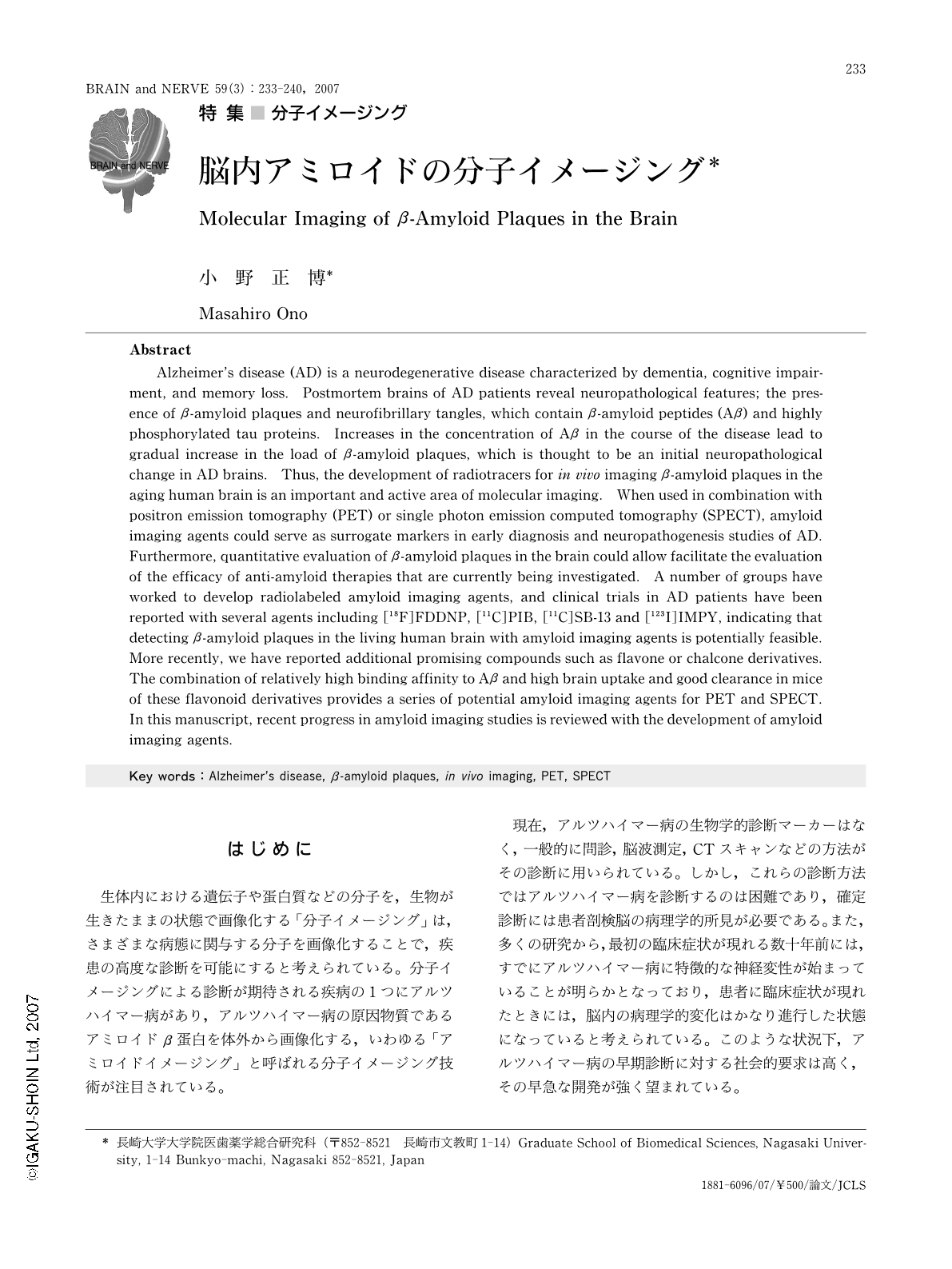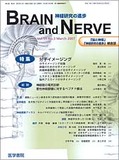Japanese
English
- 有料閲覧
- Abstract 文献概要
- 1ページ目 Look Inside
- 参考文献 Reference
はじめに
生体内における遺伝子や蛋白質などの分子を,生物が生きたままの状態で画像化する「分子イメージング」は,さまざまな病態に関与する分子を画像化することで,疾患の高度な診断を可能にすると考えられている。分子イメージングによる診断が期待される疾病の1つにアルツハイマー病があり,アルツハイマー病の原因物質であるアミロイドβ蛋白を体外から画像化する,いわゆる「アミロイドイメージング」と呼ばれる分子イメージング技術が注目されている。
現在,アルツハイマー病の生物学的診断マーカーはなく,一般的に問診,脳波測定,CTスキャンなどの方法がその診断に用いられている。しかし,これらの診断方法ではアルツハイマー病を診断するのは困難であり,確定診断には患者剖検脳の病理学的所見が必要である。また,多くの研究から,最初の臨床症状が現れる数十年前には,すでにアルツハイマー病に特徴的な神経変性が始まっていることが明らかとなっており,患者に臨床症状が現れたときには,脳内の病理学的変化はかなり進行した状態になっていると考えられている。このような状況下,アルツハイマー病の早期診断に対する社会的要求は高く,その早急な開発が強く望まれている。
アルツハイマー病の特徴的病理学的変化として,脳内における老人斑の沈着と神経原線維変化の出現が知られている1)。前者の主構成成分はβシート構造をとったアミロイドβ蛋白であり,後者は過剰リン酸化されたタウ蛋白である。アルツハイマー病の確定診断は,患者死後脳におけるこれら病理学的変化の確認にゆだねられている。特にアミロイドβ蛋白の蓄積はアルツハイマー病発症の最も初期段階より始まることから,脳内でβシート構造をとったアミロイドβ蛋白の早期検出は,アルツハイマー病の早期診断につながると考えられる。
こうした背景をもとに,現在,脳内に蓄積した老人斑アミロイドを体外より鋭敏に画像化できる,アミロイドイメージングプローブの開発研究が活発に行われている。重篤な認知症症状が出現する前に,アルツハイマー病の早期診断を可能とする脳内アミロイドイメージング技術の開発は,早期治療の導入により,重度の患者を減少させることが可能になると考えられる2-4)。また,アルツハイマー病と臨床的に類似したほかの認知症性疾患との鑑別診断,病状進行の判定,薬剤の治療効果の判定にもその有用性が期待される。さらに,アルツハイマー病患者とその家族の精神的および経済的負担の軽減にも,早期診断は極めて重要であり,その意義は大きいと考えられる。本稿では,アルツハイマー病の診断を目的とする脳内アミロイドの分子イメージング技術について,アミロイドイメージングプローブの開発状況とともに薬学的視点から概説を行う。
Abstract
Alzheimer's disease (AD) is a neurodegenerative disease characterized by dementia, cognitive impairment, and memory loss. Postmortem brains of AD patients reveal neuropathological features; the presence of β-amyloid plaques and neurofibrillary tangles, which contain β-amyloid peptides (Aβ) and highly phosphorylated tau proteins. Increases in the concentration of Aβ in the course of the disease lead to gradual increase in the load of β-amyloid plaques, which is thought to be an initial neuropathological change in AD brains. Thus, the development of radiotracers for in vivo imaging β-amyloid plaques in the aging human brain is an important and active area of molecular imaging. When used in combination with positron emission tomography (PET) or single photon emission computed tomography(SPECT), amyloid imaging agents could serve as surrogate markers in early diagnosis and neuropathogenesis studies of AD. Furthermore,quantitative evaluation ofβ-amyloid plaques in the brain could allow facilitate the evaluation of the efficacy of anti-amyloid therapies that are currently being investigated. A number of groups have worked to develop radiolabeled amyloid imaging agents, and clinical trials in AD patients have been reported with several agents including[18F]FDDNP,[11C]PIB,[11C]SB-13 and[123I]IMPY, indicating that detecting β-amyloid plaques in the living human brain with amyloid imaging agents is potentially feasible. More recently, we have reported additional promising compounds such as flavone or chalcone derivatives. The combination of relatively high binding affinity to Aβand high brain uptake and good clearance in mice of these flavonoid derivatives provides a series of potential amyloid imaging agents for PET and SPECT. In this manuscript,recent progress in amyloid imaging studies is reviewed with the development of amyloid imaging agents.

Copyright © 2007, Igaku-Shoin Ltd. All rights reserved.


